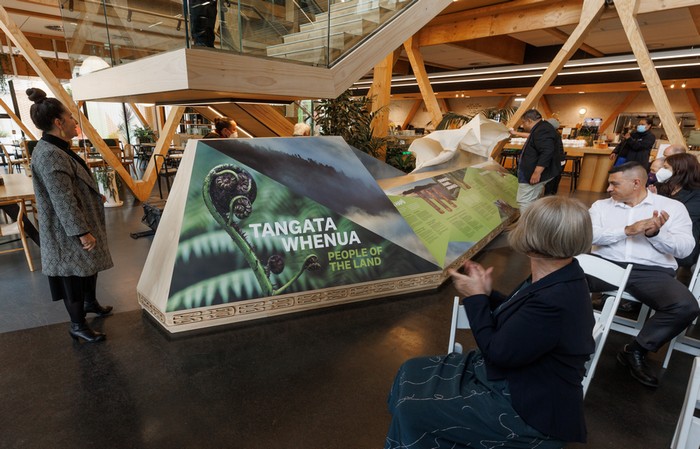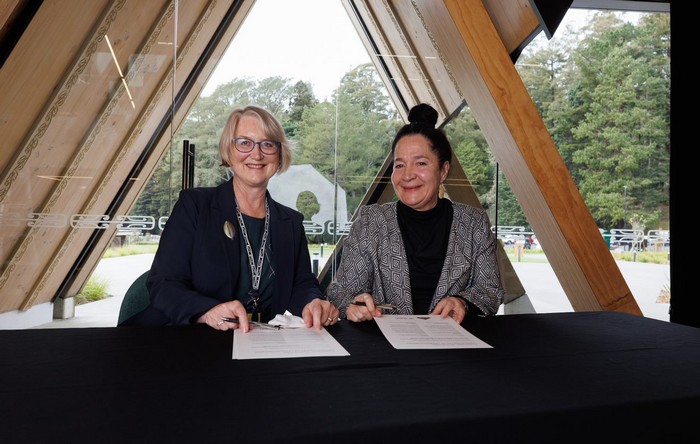Tangata Whenua - English
Ngā Hapū
Ko Moerangi te maunga, ko Puarenga te awa.
Ko Ngāti Hurungaterangi, ko Ngāti Taeotu, ko Ngāti Te Kahu ngā hapū.
Nau mai, haere mai. We welcome you. This land around you is our ancestral home, it is full of our landmarks and histories.
Ko te whenua – This land
Land is the basis of identity and wellbeing for our people. We are genealogically connected through our whakapapa to the land itself, as we trace our ancestry from Papatūānuku (the earth mother) and Ranginui (the sky father). Our whakapapa ties to the land and the various parts of the natural environment are fundamental aspects of our culture and our lives. Whakapapa and whanaungatanga – our family trees and relationships – give rise to obligations to look after the land, the waters and the environment on behalf of our ancestors and ourselves for future generations.
Ngā Hapū e Toru’s land is part of the Whakarewarewa No. 1 block, which contains various pā sites including Te Mingi, Turikori, Puhirua and Titokorangi. At these pā and kāinga, there were wharepuni and tūāhu (houses and sacred places or altars), as well as urupā (burial sites).
Ko Tuteata te tangata, ko Hapuriri te wahine
Tuteata was the great-grandson of Rangitihi, a famous Te Arawa ancestor. Te Arawa is the deep-sea sailing waka that brought our people here from Hawaiki. Through our whakapapa to Tuteata and his wife Hapuriri, we inherited the land that has passed down to Ngāti Hurungaterangi, ko Ngāti Taeotu, ko Ngāti Te Kahu.
Te Whare Nui o Tuteata – the great house of Tuteata, is named in honour of our ancestor.
This significant name was gifted by our hapū who are ahi kā – the whānau groups who have mana, rights and authority over this whenua.
Our hapū have also gifted the kōwhaiwhai patterns used in this building. These patterns come from the wharenui Hurungaterangi, at Ngāpuna, which is two kilometres north from here.
Ko Ngāti Hurungaterangi, ko Ngāti Taeotu, ko Ngāti Te Kahu ngā hapū
The three hapū of this area are Ngāti Hurungaterangi, Ngāti Taeotu, and Ngāti Te Kahu. We are whānau groups who trace our ancestry back 15 generations to Tuteata and Hapuriri.
Hurungaterangi and Whaingārangi
- Tuteata’s eldest child was Tūwhakairikawa and his line of descent culminated in Whaingārangi. She held ancestral rights to this land, as ownership and mana whenua passed to her. Her husband was a warrior named Hurungaterangi. By avenging the death of his father, Hurungaterangi established rights by conquest as an additional source of authority over this land. They raised their children on the whānau land of Whaingārangi, for example at Ngāpuna, Ōwhatiura and Whakarewarewa.
Taeotu and Paretuhi
- Taeotu was married to Paretuhi. Their descendants lived mainly at Ōhinemutu, Ōwhatiura and Whakarewarewa but also in parts of Rotomahana-Parekārangi. The chief Te Rangiiwaho on his death bed gave this korero to Taeotu: “Goodbye, remain here, hold fast to the lands of Rotorua – plait the cable of the land, if it breaks join it again, remain here at Piopio and Te Hemo.” This instruction was to keep unity amongst the people and maintain the ties to this land.
Te Kahu and Kōhuru
- Te Kahu was the daughter of Hinekura of Ngāti Tuteata and Tarawhiti of Ngāti Uenukukōpako. Te Kahu’s husband was Kōhuru of Ngāti Tūmatawera. Their descendants have lived and cultivated at Tumunui, at the southern end of Lake Rotokākahi, Whakarewarewa and Tihiōtonga.
Past, Present, Future
For hundreds of years, descendants of Tuteata and Hapuriri lived in pā and kāinga and developed cultivations here. There were many wāhi tapu (sacred sites) on the land. Today, you will see poupou whenua standing on the land near the forest.
The world of our ancestors
This whenua (land) was rich in birdlife, plants and food sources. The whānau and hapū had many cultivations nearby with kai (food), such as the aruhe (fern root) and kūmara (sweet potato). Tawa and karaka berries were gathered and then cooked in geothermal waters or in ngāwhā steam vents and then would be spread out over stones to dry and be preserved.
The nearby Puarenga Stream was an abundant food source. There were different birds snared along the Puarenga such as shags and ducks. Whānau would fish for īnanga (whitebait), kokopu (cockabully) and kōura (freshwater crayfish). Raupō (bulrush) was an important plant from the Puarenga, which could be used for dwellings. It was also a unique and valuable food source where the roots, stalks and seeds could be prepared in different ways. The raupō filtered the waterways and provided a habitat for fishlife.
On these lands were taonga such as the prized and rare kōkōwai (red ochre clay). When it was sourced, a rāhui (restriction) was placed on the kōkōwai and the area was made tapu. The kōkōwai had different uses, including to adorn and colour whare (houses).
Ngāwhā (geothermal energy) is a special feature of this area and is still used for cooking food. There are various hot springs nearby for bathing and medicinal purposes. There was also a significant flax swamp nearby and the hot springs are still used to prepare harakeke (flax) for weaving to make clothes, mats and baskets.

Arrival of Tauiwi
In the 1800s, European migrants started arriving in the Rotorua district. Ngāti Whakaue did not sign the Treaty of Waitangi, but instead signed the Fenton Agreement in 1880. Under this agreement our Ngāti Whakaue tūpuna (ancestors) saw the benefits of establishing a township but were unwilling to sell the land. Rather, it was agreed that settlers could sign 99-year leases. The Crown was to oversee these leases.
However, the Fenton Agreement was not upheld. Land laws and Crown purchases took the traditional lands away from Māori ownership. In less than 10 years, the government had secured 90% of the Whakarewarewa land block. The Rotorua township lease scheme fell apart and by 1894, in the Whakarewarewa land blocks, Ngāti Whakaue were virtually landless.
This particular area was used by the government as a nursery from 1898 and for forestry research from 1947. The physical connection of hapū to this land was severed during that time. However, the spiritual connection has never been cut. The sense of loss of the whenua is still raw today.
Aspirations of the hapū
Today the vision of the three hapū is to embrace and build partnerships.
This will contribute to our tino rangatiratanga, our self-determination. We will be independent and will map out our future.
This land is part of our rohe and our tūrangawaewae, the place where we stand. We will maintain the strength of our culture with pride. Our younger generations will know the whenua and whakapapa, the land, its history and our family connections.
With our marae at the centre, our ahi kā, those people who keep the home-fires alight, will be strong. Our whānau will be healthier and have better wellbeing.
We will keep working so that our lands, waters and taonga are returned, and are healthy and unpolluted. The mauri will be strong.
Our mokopuna (descendants) will have an enriched education and will grow up walking confidently in both worlds.
We will be the best we can be and will act with aroha (love). We will mark the world with our presence, for our tūpuna and our mokopuna, generations of the past and those of the future.

Te Kawenata/MoU
Looking to the future, our hapū are building a relationship with Scion to reconnect our people and traditions to this land. The name of this campus, Te Papa Tipu – land on which to grow – is appropriate.
That growth is shared in our partnership based on this Memorandum of Understanding between the hapū and Scion.
